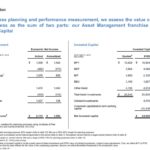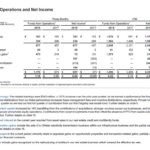Contents
Summary
- BAM reported strong Q1 2018 results on May 10, 2018.
- At the end of Q1 2018 (March 31st), BAM maintained core liquidity and uncalled private fund commitments of $32B. It also generated over $2.5B of annual free cash flow from its asset management business and distributions from invested capital.
- I wish to have exposure to alternative assets but lack the expertise and resources to properly analyze same. My exposure to BAM allows me to benefit from its expertise and success with such investments.
Introduction
Brookfield Asset Management (NYSE: BAM TSX: BAM-A) is a leading global alternative asset manager, focused on investing in long-life, high-quality assets across real estate, renewable power, infrastructure and private equity. It provides a wide variety of investment products to its investors including private funds, listed issuers, and public securities.
Source: BAM 2017 Annual Report page 8 of 196
BAM’s interests are aligned with its investors because it invests large amounts of its own balance sheet capital in its funds; BAM is typically the largest investor in its private funds and the largest investor in each of its four flagship publicly listed partnerships:
- Brookfield Property Partners L.P. (NYSE: BPY);
- Brookfield Renewable Partners L.P. (NYSE: BEP);
- Brookfield Infrastructure Partners L.P. (NYSE: BIP);
- Brookfield Business Partners L.P. (NYSE: BBU).
BAM’s financial returns are represented primarily by the combination of fees earned as an asset manager as well as capital appreciation and distributions from its invested capital.
Please refer to the ‘Differentiation’ section of my February 18, 2018 article wherein I touch upon why BAM appeals to me as a long-term investment. That article also addresses BAM’s historical returns and credit ratings. I also share links to BAM’s September 27, 2017 Investor Day presentation and the transcript associated with the presentation; I share these links again in this article so you can get a comprehensive overview of the company.
Additional details can also be found in my September 25, 2017, May 20, 2017, and February 10, 2017 articles and in my Low or No Dividend Yield Companies Belong in Your Portfolio.
In addition to the above, I encourage you to listen to this May 1, 2018 Bloomberg interview in which Bruce Flatt (BAM’s CEO) explains the opportunities BAM sees in real estate.
For the sake of full disclosure, I hold the TSX listed BAM shares in the FFJ Portfolio and also in accounts I do not publicly disclose. Shares are held in Tax Free Savings Accounts, Registered Accounts, and in Non-Registered accounts. I also acquired additional BAM shares in February 2018.
Q1 2018 Financial Results
On May 10, 2018, BAM reported Q1 2018 results; please note that BAM reports its results in USD.
BAM continues to generate increasingly significant free cash at the corporate level.
Source: BAM Q1 2018 Supplemental Information Presentation
Investment performance has been strong across the business and fundraising for BAM’s latest flagship real estate fund is well advanced. This is BAM’s 3rd real estate flagship fund and over $9B has been raised after the first close. This amount matches the total capital in the predecessor fund in the series of funds and BAM is confident it will raise substantial further capital throughout the remainder of 2018 thereby making it the largest real estate fund to date.
As I mentioned in previous articles, BAM has build a reputation such that it now has a far broader pool of potential investors; it is receiving increased commitments from clients outside North America and increased allocations from both public and private pension plans.
On an annual basis, BAM received ~$1B in asset management fee related earnings and ~$1.5B of cash distributions annually from invested capital. Deduct the ~$0.5B of interest expense, preferred share dividends and corporate costs, and BAM is generating ~$2B of cash flows before common share dividends which can be distributed or reinvested.
BAM has few capital requirements at the corporate level. This enables it to use cash flow to support larger fund transactions, to provide bridge capital, and to seed new fund products.
BAM currently has $22B of third-party private fund commitments and $10B of core liquidity which can be deployed toward future opportunities.
Source: BAM Q1 2018 Supplemental Information Presentation
Valuation
Please refer to the ‘Basis of Presentation’ section of BAM’s Q1 2018 Earnings Release for an explanation as to the importance of Funds from Operations (FFO) and why BAM uses FFO to assess its operating results and the value of BAM’s business even though it is a non-IFRS measure.
In my February 18, 2018 article I indicated that BAM had generated $3.74/share in FFO in FY2017. BAM’s $40.28 closing stock price on February 16, 2018 was ~10.78 times its FFO.
In the May 10, 2018 Earnings Release, BAM reported $1.16/share in FFO for Q1 versus $0.65/share in Q1 2017. For the last 12 months ending March 31, 2018, BAM reported $4.25/share in FFO versus $3.15/share for the prior period ending March 31, 2017. BAM closed at $40.61 on May 10, 2018 and on this basis the stock is currently trading at ~9.56 times its FFO.
From a diluted EPS perspective, BAM reported $1.25/share for the 12 months ending March 31, 2017. It has now reported $2.26/share for the 12 months ending March 31, 2018 which works out to a ~18 PE using the May 10th $40.61 closing stock price. I view this valuation as fair for a company of BAM’s quality.
Dividend and Dividend Yield
BAM’s dividend history can be found here.
I have indicated in previous articles that BAM is not an investment which will appeal to investors whose priority is to generate a stream of dividend income. While BAM rewards investors with a small dividend (the dividend yield is typically sub 1.5%), BAM can generate far better returns by redeploying earnings into new investment opportunities.
Final Thoughts
While I feel reasonably confident in being able to assess the quality of ‘conventional’ publicly traded companies, I am far less confident in my ability to analyze alternative assets. Since I wish to have exposure to alternative assets but lack the expertise to properly evaluate same, I have elected to invest in BAM.
BAM has a proven track record of success as borne out by its ability to attract increasingly larger pools of capital for deployment. In my opinion, if extremely astute sovereign and institutional investors are prepared to entrust billions of dollars to BAM for the purpose of generating attractive long-term investment returns it behooves me to invest in BAM for my personal benefit.
As I noted in my February 18, 2018 article, BAM manages its business so as to generate 12% - 15% compound returns over the longer term. Anyone interested investing in BAM should, therefore, be prepared to invest for the long-term (ie. a minimum of 10 years).
I hope you enjoyed this post and I wish you much success on your journey to financial freedom.
Thanks for reading!
Note: I sincerely appreciate the time you took to read this article. Please send any feedback, corrections, or questions to [email protected]
Disclaimer: I have no knowledge of your individual circumstances and am not providing individualized advice or recommendations. I encourage you not to make any investment decision without conducting your own research and due diligence. You should also consult your financial advisor about your specific situation.
Disclosure: I am long TSX: BAM.a.
I wrote this article myself and it expresses my own opinions. I am not receiving compensation for it and have no business relationship with any company whose stock is mentioned in this article.







